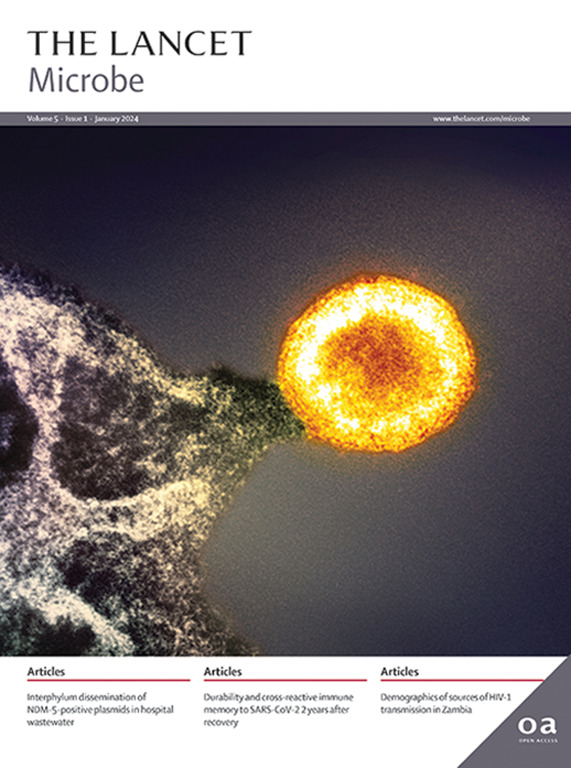2011年至2023年澳大利亚侵袭性化脓性链球菌的时间和地理谱系动态:一项回顾性、多中心、临床和基因组流行病学研究
IF 20.9
1区 生物学
Q1 INFECTIOUS DISEASES
引用次数: 0
摘要
背景:确定侵袭性化脓性链球菌(A组链球菌)的时间动态以及高流行区和低发病率区之间的差异,为了解病原体进化提供了重要的见解,进而为预防措施提供了信息。我们的目的是研究化脓性链球菌在澳大利亚不同疾病环境下的临床和时间谱系动态,以提高对病原体多样性驱动因素的理解。方法:在这项回顾性、多中心、临床和基因组流行病学研究中,我们在2011年1月1日至2023年2月28日期间从正常无菌部位发现了侵袭性化脓性沙门氏菌感染病例。数据收集自澳大利亚温带东南部低发病率地区和澳大利亚北领地高流行区、热带地区和大部分偏远地区的五个医院网络。采用准泊松回归法估计了澳大利亚东部和东南部以及原住民与非原住民之间血流S化脓性感染的粗发病率比(IRR)。我们使用logistic回归估计了高端地区与澳大利亚东南部地区重症监护病房(ICU)入院、住院死亡率和30天死亡率的比值比(ORs)。检索和成功测序的分离株在全基因组分辨率下被分配谱系。比较了两个地区共循环谱系组成的时间趋势。我们使用化脓性S特异性多菌株模拟传播模型来研究宿主种群特异性参数与观察到的病原体谱系动力学之间的关系。研究人员比较了不同地理和时间时期的辅助基因(占所有基因组的5-95%)的流行程度,以研究基因组多样性的驱动因素。结果:我们在澳大利亚的患者中发现了500例侵袭性化脓性S感染,在澳大利亚东南部患者中发现了495例。在整个研究期间,与澳大利亚东南部相比,高端地区血液感染的粗IRR为5.97 (95% CI 4.61 - 7.73);在高端,与非原住民相比,原住民的感染率不成比例(5.41,4.28 - 6.89)。住院死亡率(OR = 0.43, 95% CI = 0.26 ~ 0.70)、30天死亡率(0.38、0.23 ~ 0.63)和ICU入院率(0.42、0.30 ~ 0.59)均低于澳大利亚东南部。对642个S化脓基因基因组的纵向谱系分析发现,在Top End有不同谱系的替代波,而澳大利亚东南部有少数持续存在的优势谱系,并且在频率上循环。当使用高传播率、小人口规模和高水平的人类运动时,传播模型定性地再现了具有不同谱系的类似替代模式,这些特征与高地方性的Top End社区相似。使用较低的传播率,较大的人口规模,以及与澳大利亚东南部城市化社区相似的较低水平的迁移,传播模型定性地再现了频率循环的优势谱系模式。尽管有不同的循环谱系,但辅助基因在细菌群体中的流行在不同的地理和时间时期保持不变。解释:在高流行环境中,不同化脓性链球菌谱系的替换发生在波浪中,这可能与该环境中不成比例的疾病负担和稀疏的人口有关。细菌基因频率的维持可能与多位点选择相一致。这些发现表明,谱系特异性干预措施(如正在开发的疫苗)应考虑疾病背景,如果没有广泛的交叉保护,可能导致谱系替代。资助:国家卫生和医学研究委员会和Leducq基金会。本文章由计算机程序翻译,如有差异,请以英文原文为准。
Temporal and geographical lineage dynamics of invasive Streptococcus pyogenes in Australia from 2011 to 2023: a retrospective, multicentre, clinical and genomic epidemiology study
Background
Defining the temporal dynamics of invasive Streptococcus pyogenes (group A Streptococcus) and differences between hyperendemic and lower-incidence regions provides crucial insights into pathogen evolution and, in turn, informs preventive measures. We aimed to examine the clinical and temporal lineage dynamics of S pyogenes across different disease settings in Australia to improve understanding of drivers of pathogen diversity.
Methods
In this retrospective, multicentre, clinical and genomic epidemiology study, we identified cases of invasive S pyogenes infection from normally sterile sites between Jan 1, 2011, and Feb 28, 2023. Data were collected from five hospital networks across low-incidence regions in temperate southeast Australia and the hyperendemic, tropical, and largely remote Top End of the Northern Territory of Australia. The crude incidence rate ratio (IRR) of bloodstream S pyogenes infection comparing the Top End and southeast Australia and in First Nations people compared with non-First Nations people was estimated by quasi-Poisson regression. We estimated odds ratios (ORs) of intensive care unit (ICU) admission, in-hospital mortality, and 30-day mortality for the Top End versus southeast Australia using logistic regression. Retrieved and successfully sequenced isolates were assigned lineages at whole-genome resolution. Temporal trends in the composition of co-circulating lineages were compared between the two regions. We used an S pyogenes-specific multistrain simulated transmission model to examine the relationship between host population-specific parameters and observed pathogen lineage dynamics. The prevalence of accessory genes (those present in 5–95% of all genomes) was compared across geographies and temporal periods to investigate genomic drivers of diversity.
Findings
We identified 500 cases of invasive S pyogenes infection in patients in the Top End and 495 cases in patients in southeast Australia. The crude IRR of bloodstream infection for the Top End compared with southeast Australia was 5·97 (95% CI 4·61–7·73) across the entire study period; in the Top End, infection disproportionately affected First Nations people compared with non-First Nations people (5·41, 4·28–6·89). The odds of in-hospital mortality (OR 0·43, 95% CI 0·26–0·70), 30-day mortality (0·38, 0·23–0·63), and ICU admission (0·42, 0·30–0·59) were lower in the Top End than in southeast Australia. Longitudinal lineage analysis of 642 S pyogenes genomes identified waves of replacement with distinct lineages in the Top End, whereas southeast Australia had a small number of dominant lineages that persisted and cycled in frequency. The transmission model qualitatively reproduced a similar pattern of replacement with distinct lineages when using a high transmission rate, small population size, and high levels of human movement—characteristics similar to those of communities in the hyperendemic Top End. Using a lower transmission rate, larger population size, and lower levels of migration similar to those of communities in urbanised southeast Australia, the transmission model qualitatively reproduced a pattern of dominant lineages that cycled in frequency. Despite distinct circulating lineages, the prevalence of accessory genes in the bacterial population was maintained across geographies and temporal periods.
Interpretation
In a hyperendemic setting, the replacement of distinct S pyogenes lineages occurred in waves, which could be linked to the disproportionate burden of disease and sparse human population in this setting. The maintenance of bacterial gene frequency could be consistent with multilocus selection. These findings suggest that lineage-specific interventions—such as vaccines under development—should consider disease setting and, without broad cross-protection, might lead to lineage replacement.
Funding
National Health and Medical Research Council, and Leducq Foundation.
求助全文
通过发布文献求助,成功后即可免费获取论文全文。
去求助
来源期刊

Lancet Microbe
Multiple-
CiteScore
27.20
自引率
0.80%
发文量
278
审稿时长
6 weeks
期刊介绍:
The Lancet Microbe is a gold open access journal committed to publishing content relevant to clinical microbiologists worldwide, with a focus on studies that advance clinical understanding, challenge the status quo, and advocate change in health policy.
 求助内容:
求助内容: 应助结果提醒方式:
应助结果提醒方式:


